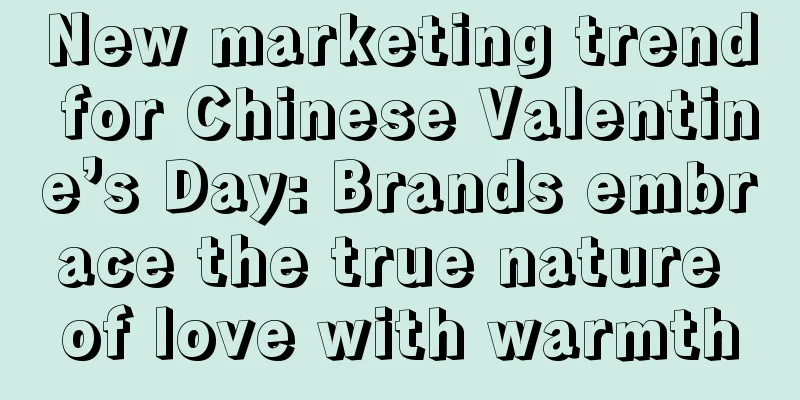Why is the new Chinese-style marketing only popular but not explosive?

After "New Chinese Style" became the code for traffic, a number of brands also rushed to it. Some brands have taken the lead in making a fuss about packaging. Tea brands such as Cha Baidao and Guming have incorporated calligraphy into the packaging design. The brushstrokes are filled with China’s thousands of years of cultural heritage, thereby attracting young users with “awakened blood”. Some brands also use joint ventures to try to embellish their brand image with new Chinese elements. Last year, the horse-faced skirt became a popular new Chinese item, and Shanghai Auntie also took advantage of the popularity of the horse-faced skirt and collaborated with related brands to attract traffic for the new product. Some brands are even trying out new concepts on the product side. For example, The Beast has collaborated with the intangible cultural heritage crafts of Yunnan Yi embroidery and Xuxing straw weaving to enhance the product image with a simple and unique cultural core. However, while new Chinese-style marketing is in full swing, there are also brands that are "stumbling" over the new Chinese-style concept. Luckin Coffee, the "general who always wins" in the co-branding circle, will naturally not miss the trend of new Chinese style. This time, Luckin Coffee has a great chance of winning at the beginning. It co-branded with the dance drama "Dream of Red Mansions" which is popular on social platforms such as Douyin and Xiaohongshu, and took the opportunity to propose the concept of "new Chinese coffee". It was thought that with the traffic appeal of the dance drama "Dream of Red Mansions", Luckin's joint venture would definitely cause a "bloodbath" on the social platforms. However, what no one expected was that this much-anticipated joint event ultimately failed due to the "three-no" peripheral products. In addition to Ideal MEGA, which passively played with the "Chinese horror", some car companies have begun to use "new Chinese aesthetics" as their marketing direction. In order to warm up the new model, Hongqi pushed the topic #this car has a new Chinese aesthetics# to the hot search. However, the released promotional materials made many Hongqi users sigh that the Hongqi EH7, which blindly pursued new Chinese elements, has lost its "most recognizable characteristics." In fact, after removing the traffic bubble, it is not difficult to find that although the new Chinese style marketing is booming, it has not produced a hit case that has attracted thousands of people. Why did the new Chinese style fail this time? 1. Doubts are raised before the benefits are realizedLeveraging marketing and moving closer to the hottest consumer trends have always been a routine move for brands, which has enabled them to arouse the attention of young users to the greatest extent. Last year, the outdoor concept was very popular, and brands flocked to it, launching outdoor-related products, joint names and cooperation one after another. Now, the wind has changed, and "New Chinese Style" has become a hot trend. Since the second half of last year, the concept of "New Chinese Style" has gradually gained momentum driven by various factors, first reflected in the clothing and apparel track. Subsequently, young people with awakened blood led a "New Chinese Aesthetics" movement, vigorously exploring the charm of traditional culture. Brands that have keenly captured consumer trends have also acted quickly, using the new Chinese concept as a guide and drawing on the heritage of traditional culture to gather around the new Chinese concept and capture young users. However, there is no panacea for marketing, and there is no shortcut to innovation. In order to catch up with the craze of new Chinese style as quickly as possible and gain a popular effect, many brands have not given it in-depth thinking and have rigidly put on the shell of new Chinese style. Eventually, the proliferation of new Chinese style has begun to make users question the brands. First of all, although the new Chinese aesthetics has been deeply recognized by young users, homogeneous marketing ideas continue to impact users' aesthetics, and users are gradually entering a period of visual fatigue with new Chinese marketing. The "calligraphy cups" launched by tea brands are one example. In addition to the above-mentioned Cha Baidao and Guming, tea brands of all sizes, such as Heytea, Cha Yan Yue Se, and Jasmine Milk White, have successively used traditional calligraphy as a marketing idea and launched "calligraphy cups". Although traditional calligraphy on tea packaging is stunning enough at first sight, the subsequent marketing methods that are obviously similar have made this idea fall into clichés and been abandoned by users. Secondly, when brands blindly pursue the new Chinese trend, they tend to neglect the deep interaction between marketing and users, which in turn damages the brand reputation and loses user trust. Luckin Coffee's collaboration with the dance drama Dream of Red Mansions is one of the proofs. Accustomed to Luckin Coffee's high-profile marketing moves, users have always had high expectations for Luckin Coffee's collaborations. However, perhaps because the preparation time was too hasty, Luckin Coffee's collaboration not only did not launch new products, but also did not give away cup sleeves, paper bags, and peripherals. From the perspective of appearance design, there is no unique logo for any co-branded product, and many users bluntly said, "The collaboration is a lonely one." Interestingly, at the same time when Luckin Coffee was in trouble for its "three no" collaboration, Yihetang and Guigui Tea also collaborated with Dream of the Red Chamber and successfully "took advantage of the opportunity". Yihetang made a big fuss about the co-branded peripherals, including cup sleeves, paper bags, and badges. Its official account even went directly to Luckin Coffee's comment area to attract traffic, which can be said to be "close to the face and open big". Finally, the reason why the new Chinese style is different from the previous national trend is that it has a more sophisticated and unique design concept, which perfectly integrates Chinese elements with the public aesthetics, and can not only convey the Chinese charm, but also cater to the contemporary aesthetic style. Unfortunately, many brands still have a superficial understanding of the new Chinese style and fail to truly integrate Chinese aesthetics with product design. Hongqi's EH7, which uses "new Chinese aesthetics" as a gimmick, is one example. Judging from the released posters and promotional videos, this new model does not have many points of integration with the new Chinese style. Only the interior uses Kanas ripples and the body color is Yubai Green. However, these two features are not enough to support the brand's claimed "new Chinese aesthetics", which not only covers up the characteristics of the brand's original design, but also makes many users question the direction of the promotion. Although the new Chinese style traffic dividend is tempting enough, if brands want to take advantage of it to reap the benefits, they may have to work harder and cultivate their own marketing skills. 2. New Chinese style concept goes viral, and brand marketing followsJudging from the trajectory of the new Chinese style's popularity, the new Chinese style first became popular in the clothing industry, and produced a number of clothing brands positioned as "new Chinese style." However, following the popularity of the new Chinese style, many brands that are highly tied to traditional culture and Chinese characteristics have also become active, leveraging marketing opportunities and taking on traffic. Tea brands with Chinese tea drinking culture as their genes have inherent advantages in new Chinese-style marketing. In addition, tea brands have a keen marketing sense and naturally become the main force in new Chinese-style marketing. Overall, the new Chinese marketing methods of tea brands can be divided into three categories: One is to use the unique design style of naming, packaging, peripheral products, etc. to create "social symbols", leverage online traffic, and gain a circle effect. The tea brand "Xijian Chashan" is well versed in the new Chinese naming method. Yuanyang Yunling, Qingshi Hongdai, Yunyu Yanbo... The charming names combined with traditional Chinese colors have attracted many young people to take photos and check in. This type of gameplay has become the basic skill of tea brand marketing. It can not only effectively amplify the brand's differentiated characteristics, but also take advantage of the fission propagation characteristics of social platforms to form a circle-breaking effect. Of course, as the competition among tea brands becomes increasingly fierce, it is more difficult to stand out with packaging design, and it is more necessary to deeply understand the social terms of young users. The second is to highlight the brand’s Chinese elements by collaborating with national style IP. Under the new Chinese style trend, the popularity of national style IP is also increasing. Many tea brands have used the influence of IP to flexibly and quickly launch new Chinese style marketing. The influence of Shanghai Auntie and "Do You Know?", Tea Talk and "Three Thousand Miles of Chang'an", Ancient Tea and "Lotus Tower" and other cases among young users should not be underestimated. The support of the national style IP's own traffic does provide a guarantee for brand marketing. However, how to break the circle through IP and connect with a wider range of the public is also one of the challenges for the brand. The third is to collaborate with intangible cultural heritage, through which brands can create more novel perspectives and stories with more humanistic feelings. Bawang Tea Princess uses the "Fireworks and Fire Dragon", an intangible cultural heritage of Jieyang, Guangdong, as a guide and collaborates with designer brands to launch a variety of peripheral products; Nayuki joins hands with "Forbidden City Patterns" to use "Rising Dragon Pattern" and "Ruyi Cloud Pattern" as core elements to launch a joint product of incense and fireworks; Juan Tea collides with folk paper-cutting to achieve visual innovation. It is worth mentioning that pure tea has become a new rising track in the tea industry, inheriting the herbal tea and taking over the trend of new Chinese tea. For this reason, tea brands such as Bawang Chaji, Nayuki, and Heytea are rushing to join the market, creating new Chinese teahouses, targeting new consumption forms for young users, and many regional brands such as Kaiji Teahouse and Hachafu have also emerged. Different from the marketing strategy of tea brands that are competing to break the circle, beauty brands emphasize using the unique core of new Chinese style to shape the differentiated characteristics of the brand. From the product side, oriental elements have been implemented in all aspects of product design, shape, characteristics, etc.: product ingredients emphasize Chinese herbal resources, and product design draws on ancient architecture and incorporates traditional patterns. Some cosmetics brands also choose to collaborate with national style IPs to highlight the new Chinese style on packaging. The collaboration between cosmetics brand AKF and the IP of "Tang Palace Night Banquet" and Huaxizi and the Dunhuang Museum are all to highlight the Chinese style of the products. In the marketing and promotion stages, the new Chinese style and artistic conception have become the main direction of brand promotion, and "bone beauty" and "oriental temperament" are the keywords of this type of brand marketing. Different from the previous aesthetic style of pursuing girl group makeup and internet celebrity makeup, domestic beauty brands pay more attention to bone beauty. Starting from the facial features of Chinese people, they magnify the advantages of non-mainstream aesthetics such as single eyelids and square and round faces through contour outlining, eyebrow and eye charm, and personal temperament. The new Chinese makeup created by Caitang founder Tang Yi and Chen Duling was once on the hot search list of Weibo. Its cool and elegant makeup features cater to the new aesthetic trend, and many users have become interested in Caitang series products. 3. Is it just popular but not explosive? New Chinese-style marketing still needs "new ways of playing"Although brands have responded sensitively to the new Chinese style trend, the fire of the new Chinese style has never reached the brand end. On the one hand, homogeneous marketing cases confirm the brand's slackness and eagerness for quick success on the creative side. The brand's lack of new gameplay and new creativity has eroded users' interest in the new Chinese aesthetic, and the final marketing effect will be greatly reduced. on the other hand, Brands’ understanding of the concept of “New Chinese Style” is still too conservative, and they are unable to interact effectively with the language system and lifestyle of young users. Even with the traffic blessing of New Chinese Style, it is still difficult for brands to stimulate young people’s consumption enthusiasm. In fact, many brands that are positioned as "new Chinese style" and "national trend" have encountered business difficulties. The once wildly expanding new Chinese pastry brand Hutouju was the first to fall, pouring cold water on the once hot new Chinese baking track. An industry insider revealed to Doujiao that the fragrance brand Documents, which uses "Chinese fragrance" as its core selling point, is also facing financial pressure. Novel and unique concepts can indeed create a temporary consumption boom among young people. However, if the concept is not deeply and comprehensively understood and explained, it is impossible to establish stable and long-term brand value. Taking catering brands as an example, Chinese catering continues the thousand-year-old food culture. How to integrate online and offline scenes with traditional culture and public aesthetics is the key to the brand's new Chinese marketing. In the online communication field, such as live broadcast rooms, short video content, brand online store packaging, etc., Chinese pastry and catering brands all use Chinese style as the main line of content operation to achieve the unity of brand tone. Take "Frog Little Hero" as an example. Its brand is mainly based on martial arts IP, and its live broadcast room is also full of traditional martial arts style, which strengthens the user's mind. For brands such as pastries and restaurants that are mostly consumed offline, offline scenes cannot be relaxed either. In addition to store decoration style and product design, some brands invite ancient costume celebrities to participate in offline activities to attract young users to take photos and check in, thereby creating a traffic effect. Up to now, the term "New Chinese style" has not yet been clearly defined. Its connotation and extension are very rich. It goes far beyond the common categories of calligraphy, traditional colors, and intangible cultural heritage crafts, and can also be extended to many concepts such as Chinese horror and Chinese health preservation. The most important reason why young people have such a strong enthusiasm for the new Chinese style is that contemporary young people have found resonance in Chinese expression. This resonance is partly due to the younger generation's more passionate national cultural self-confidence, and partly because Chinese culture is in line with the background of the times and accurately reflects the emotions of young people. Social context is one of the ways for brands to find the interests of young people. Last year, Heytea targeted the expression pack that young users love the most - the speechless Bodhisattva. The helplessness and disgust in the expression of this pensive arhat resonated with the working state of hundreds of millions of workers and became the top trend in the Buddhist world. Heytea took advantage of the opportunity to launch a joint venture with the Jingdezhen China Ceramics Museum and launched the "I am the Buddha holding a cup" series, successfully linking the two most common topics among young people, Buddhism and speechlessness, and it rushed to the hot search list on the day it was launched. Although there were subsequent religious controversies surrounding the series of co-branded products, Heytea’s marketing ideas have indeed been recognized by young people. If Heytea resonates with young people's mental state, then Lelecha pays attention to the health needs of young people and attracts the attention of fragile young people. Today, when young people are increasingly valuing their lives, Lelecha has collaborated with Fang Huichuntang to combine Chinese health-preserving ideas with tea drinks to heal the mental outlook of vulnerable working people. Against the backdrop of young people’s growing demand for expanding their social networks, “New Chinese Style” does provide brands with an effective marketing direction. However, in order to truly maximize the effectiveness of brand communication, brands also need to break through traditional thinking and develop more diverse, personalized, and fashionable gameplay, integrating Chinese culture with the social language of young users. Author: Bukong Source: WeChat public account "Dou Jiao Spicy (ID: ylwanjia)" |
<<: New consumption (don’t) be scared by Zhong Xuegao
>>: The short play is fierce: a Pinduoduo-style victory
Recommend
I spent 5,000 yuan to buy 20 courses on selling good products on Douyin, but none of them was useful!
The author spent 5,000 yuan to buy more than 20 Do...
5 ways to innovate media
In the era of information explosion, brand communi...
How much can you earn from opening a store on Amazon in a month? How much profit can you get from opening a store?
It is said that Amazon makes money, and this is in...
Ordinary people who earn 10,000 yuan a month and want to start a business should pay attention to the following 6 points!
Starting a business is not easy and requires caref...
You can’t make money by shooting Douyin videos because you are doing it wrong!
Everyone knows the monetization ability of Douyin ...
Why do we say that Zibo BBQ understands traffic better than 90% of brands?
Zibo barbecue is very popular, and another Interne...
With 1.6 million followers added in one month and multiple videos receiving millions of likes, has the cross-dressing track produced a new hit?
Flowered bed sheets become retro high-end "dr...
Is the refund rate on Shopee high? Is it okay if I don't agree to a refund?
Because now everyone doing e-commerce needs to use...
How much profit can you make by opening a store on Amazon? How can you succeed on Amazon?
There are many people doing cross-border e-commerc...
How much is the appropriate registered capital for an Amazon business license? How much is the appropriate registered capital for an individual?
For merchants who want to do business on Amazon, r...
5 Ways to Optimize Your Advertising Campaigns in 2023
This article mainly proposes five ways to optimize...
Data drives business, I summarized the whole process of standardization
The term "driving business" is a term th...
My copywriting lost to the folk master again
Have you ever paid attention to the copywriting ar...
Dunhuang.com infringes on the intellectual property rights of others - detailed instructions
In order to regulate the platform's operating ...
What is Shopify? What are the advantages of Shopify?
There are actually quite a lot of merchants doing ...









